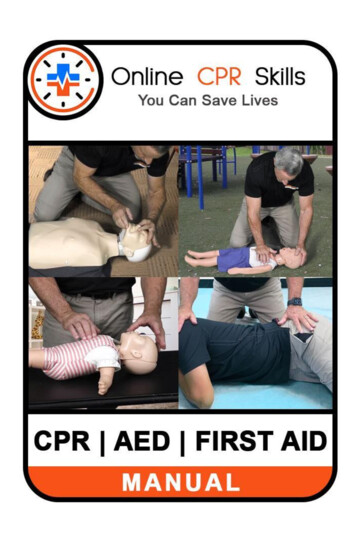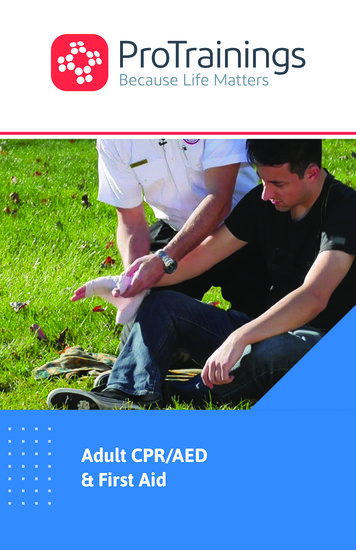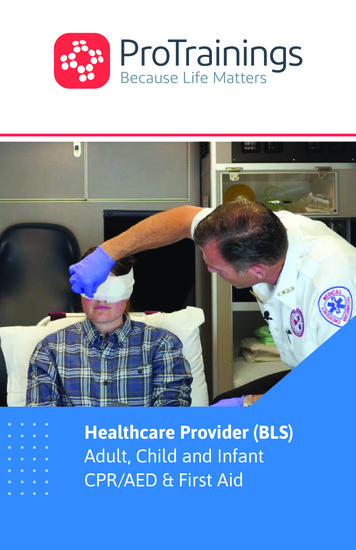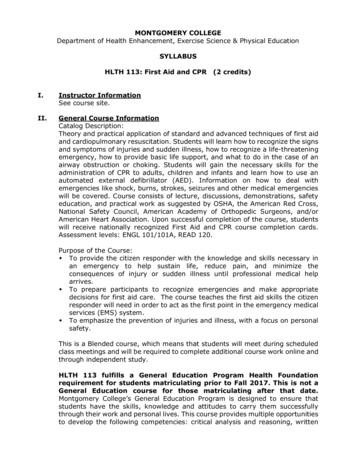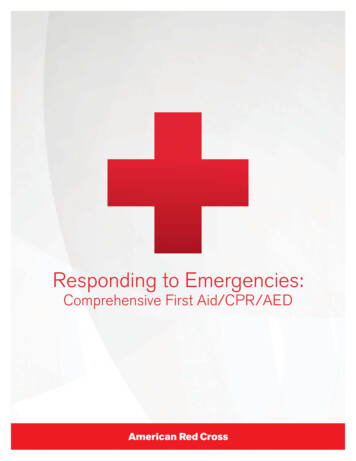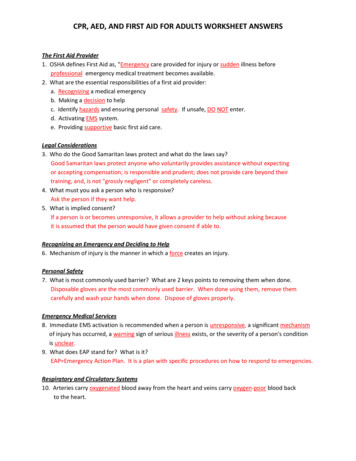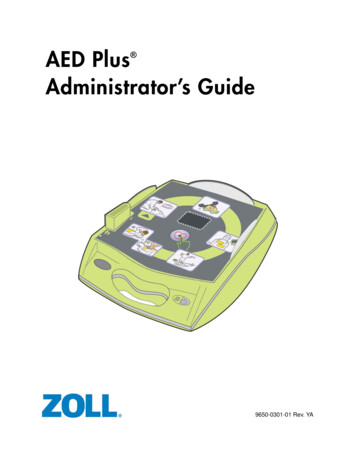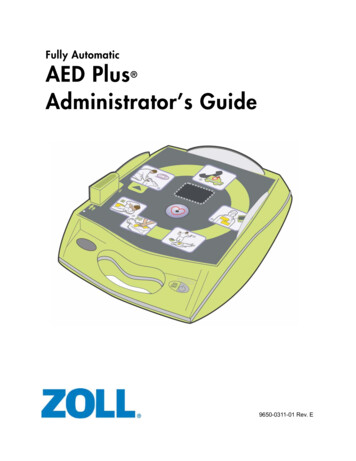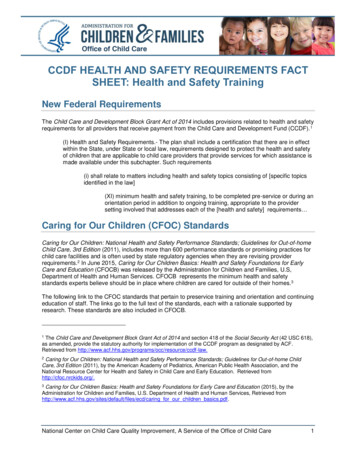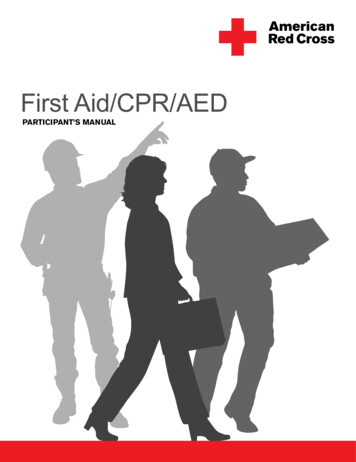
Transcription
First Aid/CPR/AEDPARTICIPANT’S MANUAL
Table of ContentsCHAPTER1SKILL SHEET:SKILL SHEET:SKILL SHEET:CHAPTER2SKILL SHEET:SKILL SHEET:SKILL SHEET:CHAPTER3SKILL SHEET:SKILL SHEET:ivAbout This ManualviiHealth Precautions and Guidelines During TrainingviiiBefore Giving Care and Checking an Injured or Ill PersonYour Role in the EMS SystemDisease Transmission and PreventionTaking Action: Emergency Action StepsChecking a Conscious PersonShockChecking an Unconscious PersonIncident StressPutting It All TogetherRemoving GlovesChecking an Injured or Ill AdultChecking an Injured or Ill Child or Infant12581416172223242527Cardiac Emergencies and CPR 29BackgroundHeart AttackCardiac ArrestPutting It All 414243AED 44When the Heart Suddenly FailsUsing an AEDAED PrecautionsHow to Use an AED—AdultsHow to Use an AED—Children and InfantsSpecial AED SituationsOther AED ProtocolsAED MaintenancePutting It All TogetherAED—Adult or Child Older Than 8 Years or Weighing More than 55 PoundsAED—Child and Infant Younger Than 8 Years or Weighing Less than 55 PoundsFirst Aid/CPR/AED Participant’s Manual4545454647474949495052
CHAPTER4SKILL SHEET:SKILL SHEET:SKILL SHEET:SKILL SHEET:SKILL SHEET:CHAPTER5Breathing Emergencies54BackgroundRespiratory Distress and Respiratory ArrestChokingPutting It All TogetherConscious Choking—AdultConscious Choking—ChildConscious Choking—InfantUnconscious Choking—AdultUnconscious Choking—Child and Infant555659656667686970Sudden Illness71Sudden IllnessSpecific Sudden IllnessesPoisoningPutting It All TogetherCHAPTERCHAPTER67SKILL SHEET:SKILL SHEET:CHAPTER8SKILL SHEET:SKILL SHEET:SKILL SHEET:SKILL SHEET:72737983Environmental Emergencies84Heat-Related Illnesses and Cold-Related EmergenciesBites and StingsPoisonous PlantsLightningPutting It All Together85889899100Soft Tissue Injuries101WoundsBurnsSpecial SituationsPutting It All TogetherControlling External BleedingUsing a Manufactured Tourniquet102109112116117118Injuries to Muscles, Bones and Joints119BackgroundTypes of InjuriesPutting It All TogetherApplying an Anatomic SplintApplying a Soft SplintApplying a Rigid SplintApplying a Sling and Binder120121129130132134136First Aid/CPR/AED Table of Contentsv
CHAPTER9Special Situations and Circumstances 138Children and InfantsEmergency ChildbirthOlder AdultsPeople With DisabilitiesLanguage BarriersCrime Scenes and Hostile SituationsPutting It All TogetherCHAPTER10SKILL SHEET:CHAPTER11SKILL SHEET:APPENDIXvi139145146147149149150Asthma 151AsthmaPutting It All TogetherAssisting With an Asthma InhalerAnaphylaxis and Epinephrine Auto-InjectorsAnaphylaxisPutting It All TogetherAssisting with an Epinephrine Auto-InjectorInjury Prevention and Emergency g It All Together164171Sources172Index175First Aid/CPR/AED Participant’s Manual
CHAPTER6Environmental EmergenciesDisease, illness and injury are not the only causes of medical emergencies. Much of our environment appears tobe relatively harmless. A weekend outing can bring you closer to the joys of nature: animals, mountains, rivers,blue skies. But it also can expose you to disease-carrying insects, other biting or stinging creatures and rapidchanges in the weather. Whereas many environmental emergencies can be avoided, even with the best preventionefforts, emergencies do occur.In this chapter you will discover how to prevent heat-related illnesses and cold-related emergencies, as well as bites andstings from insects, spiders and other animals. You also will find information on how to avoid contact with poisonousplants and how to avoid being struck by lightning. In addition, you will read about when to call for help and how to givecare until help arrives.84First Aid/CPR/AED Participant’s Manual
HEAT-RELATED ILLNESSESAND COLD-RELATEDEMERGENCIESExposure to extreme heat or cold can make a personseriously ill. The likelihood of illness also dependson factors such as physical activity, clothing, wind,humidity, working and living conditions, and a person’sage and state of mind (Fig. 6-1).Once the signals of a heat-related illness or cold-relatedemergency begin to appear, a person’s condition canquickly worsen. A heat-related illness or cold-relatedemergency can result in death. If you see any of thesignals, act quickly.People at risk for heat-related illness or a cold-relatedemergency include those who work or exercise outdoors,elderly people, young children and people with healthproblems. Also at risk are those who have had aheat-related illness or cold-related emergency in thepast, those with medical conditions that cause poorblood circulation and those who take medications toeliminate water from the body (diuretics).People usually try to get out of extreme heat or coldbefore they begin to feel ill. However, some people donot or cannot. Athletes and those who work outdoorsoften keep working even after they begin to feel ill.People living in buildings with poor ventilation, poorinsulation or poor heating or cooling systems are atincreased risk of heat-related illnesses or cold-relatedemergencies. Often they might not even recognize thatthey are in danger of becoming ill.FIGURE 6-2 Lightly stretching the muscle and gently massaging thearea, along with having the person rest and giving electrolyte- andcarbohydrate-containing fluids, usually is enough for the body torecover from heat cramps.What to Look ForHeat cramps are painful muscle spasms. They usuallyoccur in the legs and abdomen. Think of them as awarning of a possible heat-related illness.What to DoTo care for heat cramps, help the person move toa cool place to rest. Give an electrolyte- andcarbohydrate-containing fluid such as a commercialsports drink, fruit juice or milk. Water also may begiven. Lightly stretch the muscle and gently massagethe area (Fig. 6-2). The person should not take salttablets. They can worsen the situation.When cramps stop, the person usually can start activityagain if there are no other signals of illness. He or sheshould keep drinking plenty of fluids. Watch the personcarefully for further signals of heat-related illness.Heat-Related IllnessHeat cramps, heat exhaustion and heat stroke areconditions caused by overexposure to heat, loss offluids and electrolytes.Heat Cramps-9 Heat cramps are the least severe of the heat-relatedillnesses. They often are the first signals that the bodyis having trouble with the heat.9 32 FIGURE 6-1 Exposure to extreme heat or cold can make a person seriously ill.CHAPTER6 Environmental Emergencies85
Heat ExhaustionHeat StrokeHeat exhaustion is a more severe condition than heatcramps. It often affects athletes, firefighters, constructionworkers and factory workers. It also affects those whowear heavy clothing in a hot, humid environment.Heat stroke is the least common but most severeheat-related illness. It usually occurs when peopleignore the signals of heat exhaustion. Heat strokedevelops when the body systems are overwhelmedby heat and begin to stop functioning. Heat strokeis a serious medical emergency.What to Look ForSignals of heat exhaustion include cool, moist, pale,ashen or flushed skin; headache; nausea; dizziness;weakness; and exhaustion.What to DoWhen a heat-related illness is recognized in its earlystages, it usually can be reversed. Get the person out ofthe heat. Move the person to a cooler environment withcirculating air. Loosen or remove as much clothing aspossible and apply cool, wet cloths, such as towels orsheets, taking care to remoisten the cloths periodically(Fig. 6-3). Spraying the person with water and fanningalso can help.If the person is conscious and able to swallow, givehim or her small amounts of a cool fluid such asa commercial sports drink or fruit juice to restorefluids and electrolytes. Milk or water also may be given.Do not let the conscious person drink too quickly.Give about 4 ounces of fluid every 15 minutes. Let theperson rest in a comfortable position and watch carefullyfor changes in his or her condition. The person shouldnot resume normal activities the same day.If the person’s condition does not improve or he or sherefuses fluids, has a change in consciousness or vomits,call 9-1-1 or the local emergency number, as these areindications that the person’s condition is getting worse.Stop giving fluids and place the person on his or her sideto keep the airway open. Watch for signals of breathingproblems. Keep the person lying down and continueto cool the body any way you can (see What to Do UntilHelp Arrives).What to Look ForSignals of heat stroke include extremely high bodytemperature, red skin that can be either dry ormoist; changes in consciousness; rapid, weak pulse;rapid, shallow breathing; confusion; vomiting;and seizures.When to Call 9-1-1Call 9-1-1 or the local emergency number immediately.Heat stroke is a life-threatening emergency.What to Do Until Help Arrives Preferred method: Rapidly cool the body byimmersing the person up to the neck in cold water,if possible.ORDouse or spray the person with cold water.Sponge the person with ice water-doused towelsover the entire body, frequently rotating the cold,wet towels.Cover with bags of ice.If you are not able to measure and monitor theperson’s temperature, apply rapid cooling methods for20 minutes or until the person’s condition improves.Give care according for other conditions found.Cold-Related EmergenciesFrostbite and hypothermia are two types of coldrelated emergencies.FrostbiteFrostbite is the freezing of body parts exposed to thecold. Severity depends on the air temperature, lengthof exposure and the wind. Frostbite can result in theloss of fingers, hands, arms, toes, feet and legs.What to Look ForFIGURE 6-3 When you recognize a heat-related illness, get theperson out of the heat, loosen or remove clothing and apply cool, wetcloths, such as towels or sheets. Spraying the person with water andfanning also can be effective.86First Aid/CPR/AED Participant’s ManualThe signals of frostbite include lack of feeling in theaffected area, swelling and skin that appears waxy, iscold to the touch or is discolored (flushed, white, yellowor blue). In more serious cases, blisters may form andthe affected part may turn black and show signs of deeptissue damage.
When to Call 9-1-1Call 9-1-1 or the local emergency number for moreserious frostbite or seek emergency medical help as soonas possible.What to Do Until Help ArrivesTo care for frostbite, handle the area gently. Removewet clothing and jewelry, if possible, from the affectedarea. Never rub a frostbitten area. Rubbing causesfurther damage to soft tissues. Do not attempt torewarm the frostbitten area if there is a chance that itmight refreeze or if you are close to a medical facility.For minor frostbite, rapidly rewarm the affected partusing skin-to-skin contact such as with a warm hand.To care for a more serious injury, gently soak it in waternot warmer than about 105 F (Fig. 6-4, A). If you do nothave a thermometer, test the water temperature yourself.If the temperature is uncomfortable to your touch, it istoo warm. Keep the frostbitten part in the water untilnormal color returns and it feels warm (20 to 30 minutes).Loosely bandage the area with a dry, sterile dressing(Fig. 6-4, B). If fingers or toes are frostbitten, placecotton or gauze between them. Do not break any blisters.Take precautions to prevent hypothermia. Monitor theperson’s condition, and if you see that the person is goinginto shock, give care accordingly. Do not give ibuprofenor other nonsteroidal anti-inflammatory drugs (NSAIDs)when caring for frostbite.The air temperature does not have to be belowfreezing for people to develop hypothermia. This isespecially true if the person is wet or if it is windy.Elderly people in poorly heated homes can develophypothermia. The homeless, the ill and youngchildren also are at risk.Certain conditions can more easily lead to hypothermia,including: Ingestion of substances that interfere with the body’sability to regulate temperature (such as alcohol, otherdrugs and certain medications).Any medical condition that impairs circulation, suchas diabetes or cardiovascular disease.Prolonged exposure to cold, wet and/or windyconditions or wet clothing.What to Look ForSignals of hypothermia include the following: ShiveringNumbnessGlassy stareIndifferenceLoss of consciousnessShivering that stops without rewarming is a sign thatthe person’s condition is worsening. He or she needsimmediate medical care.HypothermiaIn a hypothermic condition, the entire body coolsbecause its ability to keep warm is failing. The personwill die if not given the proper care.When to Call 9-1-1Call 9-1-1 or the local emergency number immediatelyfor any case of hypothermia.100 - 105 FABFIGURE 6-4, A–B To care for more serious frostbite: A, Warm the area gently by soaking the affected part in water not warmer than 105 F. Keep thefrostbitten part in the water until normal color returns and it feels warm (20–30 minutes). B, Loosely bandage the area with a dry, sterile dressing.CHAPTER6 Environmental Emergencies87
What to Do Until Help ArrivesTo care for hypothermia, start by caring for life-threateningconditions (see below). Make the person comfortable.Gently move the person to a warm place. Remove wetclothing and dry the person. Put on dry clothing. Warm thebody gradually by wrapping the person in blankets andplastic sheeting to hold in body heat (Fig. 6-5). Also, keepthe head covered to further retain body heat.If you are far from medical care, position the personnear a heat source or apply heat pads or other heatsources to the body, such as containers filled withwarm water. Carefully monitor any heat source toavoid burning the person. Keep a barrier, such as ablanket, towel or clothing, between the heat sourceand the person.If the person is alert, give warm liquids that do notcontain alcohol or caffeine. Alcohol can cause heatloss and caffeine can cause dehydration. Do notwarm the person too quickly, such as by immersingthe person in warm water. Check breathing andmonitor for any changes in the person’s condition andcare for shock.In cases of severe hypothermia, the person may beunconscious. Breathing may have slowed or stopped.The body may feel stiff because the muscles becamerigid. Check for breathing for no more than 10 seconds.If the person is not breathing, perform CPR. Continueto warm the person until emergency medical services(EMS) personnel take over. Be prepared to use anautomated external defibrillator (AED), if available.Preventing Heat-Related Illnessesand Cold-Related EmergenciesIn general, you can prevent illnesses caused byoverexposure to extreme temperatures. To preventheat-related illnesses and cold-related emergencies,follow these guidelines: Do not go outdoors during the hottest or coldestpart of the day.Change your activity level according to the temperature.Take frequent breaks.Dress appropriately for the environment.Drink large amounts of fluids.BITES AND STINGSPeople are bitten and stung every day by insects, spiders,snakes, animals and marine life. Most of the time,these bites and stings do not cause serious problems.However, in rare circumstances, certain bites and stingscan cause serious illness or even death in people who aresensitive to the venom.Insect StingsMost of the time, insect stings are harmless. If theperson is allergic, an insect sting can lead to anaphylaxis,a life-threatening condition.What to Look ForSignals of an insect sting include: Presence of a stinger.Pain.Swelling.Signals of an allergic reaction.What to DoIf someone is stung by an insect: Remove any visible stinger. Scrape it away from the skinwith a clean fingernail or a plastic card, such as a creditcard, or use tweezers (Fig. 6-6). In the case of a bee sting,if you use tweezers, grasp the stinger, not the venom sac.Wash the site with soap and water.Cover the site and keep it clean.Apply a cold pack to the area to reduce pain and swelling.Call 9-1-1 if the person has any trouble breathingor for any other signals of anaphylaxis.Tick-Borne DiseasesFIGURE 6-5 For hypothermia, warm the bodygradually by wrapping the person in blankets orputting on dry clothing and moving him or her to awarm place. Courtesy of Canadian Red Cross.88First Aid/CPR/AED Participant’s ManualHumans can get very sick from the bite of an infectedtick. Some of the diseases spread by ticks include RockyMountain spotted fever, Babesia infection, ehrlichiosisand Lyme disease.
FOCUS ON PREVENTIONLAYER YOUR WAY TO WARMTHAs long as seasonal changes and cold climatesexist, preventing cold-related emergencies, suchas hypothermia, remains important when we workor play outside.The best way to ensure your comfort andwarmth outdoors is to layer your clothing.The first layer, called the base layer, is next toyour skin. The base layer helps to regulate yourbody temperature by moving perspiration awayfrom your skin. This is important because ifperspiration gets trapped inside your clothes,you can become chilled rapidly, which can leadto hypothermia.Thermal underwear makes a good base layer forcold weather. The fabrics that are best at movingsweat away from the skin (also called wicking) aresilk, merino wool and certain synthetics. Cotton isnot a good choice because it traps moisture ratherthan wicking it away.The job of the middle layer is insulation.This layer keeps you warm; it helps you retainheat by trapping air close to your body. Naturalfibers, such as wool and goose down, are excellentinsulators. So is synthetic fleece. Vests, jackets andtights are examples of clothing that can be wornfor insulation.The shell or outer layer protects you from wind,rain or snow. For cold weather, the shell layershould be both waterproof and “breathable.”This will keep wind and water from getting insideof the other two layers while allowing perspirationto evaporate. The shell also should be roomy enoughto fit easily over the other layers without restrictingyour movement.One of the other advantages of layering is that youcan make quick adjustments if the weather changesor you change your activity level. You can takeclothes off when you become too warm and putthem back on if you get cold.In addition to layering your clothes, to stay warm incold weather you also should wear: A hat. A scarf or knit mask that covers your faceand mouth. Sleeves that are snug at the wrist. Mittens (they are warmer than gloves). Water-resistant boots.Rocky Mountain Spotted FeverRocky Mountain spotted fever is a bacterialinfection spread by wood ticks in the westernUnited States, dog ticks in the eastern UnitedStates, and other ticks in the southern UnitedStates. Rocky Mountain spotted fever occursmostly in the spring and summer, and mostcases occur in children.What to Look ForSignals of Rocky Mountain spotted feverusually appear between 2 and 14 days after atick bite.Initial signals of Rocky Mountain spottedfever include the following:FIGURE 6-6 If someone is stung by an insect, scrape the stinger away from the skinwith a clean fingernail or a plastic card, such as a credit card. FeverNauseaCHAPTER6 Environmental Emergencies89
VomitingMuscle aches or painLack of appetiteSevere headacheEhrlichiosisMost cases of infection with the bacteria ehrlichia inhumans are caused by bites by an infected Lone Startick, and occur mainly in the southern, eastern andsouth-central United States.Later signals include: Rash: The spotted rash usually starts a few days afterfever develops. It first appears as small spots on thewrists and ankles. It then spreads to the rest of thebody. However, about one-third of persons infectedwith the illness do not get a rash.Abdominal pain.Joint pain.Diarrhea.What to Look ForMany people with ehrlichiosis do not become ill.Some develop only mild signals that are seen5 to 10 days after an infected tick bit the person.Initial signals include the following: When to Seek Medical CareCall a health care provider if the person developssignals of Rocky Mountain spotted fever after a tick bite.The health care provider is likely to prescribe antibiotics.In most cases, the person will recover fully. If leftuntreated, complications of Rocky Mountain spottedfever can be life threatening.Babesia also called Babesiosis is a protozoa infectionspread by deer ticks and black-legged ticks. It is morecommon during warm months, and most cases happenin the northeast and upper Midwest regions of theUnited States.What to Look ForMany people infected with Babesia have no apparentsymptoms. Some people may have flu-like symptoms,such as: FeverSweatsChillsBody aches and headachesNo appetiteNauseaFatigueOthers infected with Babesia develop a type of anemiathat can cause jaundice and dark urine. In some people,the disease can be life threatening if untreated. The elderlyand persons with no spleen, a weak immune system or aserious health condition are the most susceptible.When to Seek Medical CareIf a person develops any of the signals described above,he or she should seek medical care. Most people withsignals of the disease can be treated successfully withprescription medications.90First Aid/CPR/AEDOther signals that may develop include the following: Nausea VomitingDiarrheaCoughJoint painsConfusionRash (in some cases) Babesia Infection Participant’s ManualFeverHeadacheFatigueMuscle aches When to Seek Medical CareIf the person becomes ill with any of the abovesignals described, he or she should seek medicalcare. Ehrlichiosis is treated with antibiotics.Lyme DiseaseLyme disease is spreading throughout the United States.Although it is most prevalent on the east coast andthe upper Midwest, cases of Lyme disease have beenreported in all 50 states.Lyme disease is spread by the deer tick and black-leggedtick, which attaches itself to field mice and deer. Deerticks are tiny and difficult to see (Fig. 6-7). They aremuch smaller than the common dog tick or wood tick.They can be as small as a poppy seed or the head of apin. Adult deer ticks are only as large as a grape seed.Because of the tick’s tiny size, its bite usually is painless.Many people who develop Lyme disease cannot recallhaving been bitten.The tick is found around branches and in woodedand grassy areas. Like all ticks, it attaches itself to anywarm-blooded animal with which it comes into directcontact, including humans. Deer ticks are activeany time the temperature is above about 45 F.However, most cases of infection happen betweenMay and late August, when ticks are most active and
FIGURE 6-7 Deer ticks are tiny and difficult to see. iStockphoto.com/Martin Pietak.people spend more time outdoors. Recent studiesindicate that the tick must remain embedded in humanskin for about 36 to 48 hours to transmit the disease.More information on Lyme disease may be availablefrom your local or state health department, theAmerican Lyme Disease Foundation (aldf.com), or theCenters for Disease Control and Prevention (CDC)(cdc.gov/features/lymedisease/).What to Look ForThe first signal of infection may appear a few daysor a few weeks after a tick bite. In 80 to 90 percentof all cases of Lyme disease, a rash starts as a smallred area at the site of the bite. It may spread up to7 inches across (Fig. 6-8). In fair-skinned people,the center may be a lighter color with the outer edgesred and raised. This sometimes gives the rash abull’s-eye appearance. In some individuals, therash may appear to be solid red. In dark-skinnedpeople, the area may look black and blue, like a bruise.The rash may or may not be warm to the touch andusually is not itchy or painful. If a rash does appear,it will do so in about 1 to 2 weeks and may last for about3 to 5 weeks. Some people with Lyme disease neverdevelop a rash.Other signals of Lyme disease include fever, headache,weakness, and joint and muscle pain. These signalsare similar to signals of flu and can develop slowly.They might not occur at the same time as the rash.Lyme disease can get worse if it is not treated.Signals can include severe fatigue; fever; a stiff,aching neck; tingling or numbness in the fingers andtoes; and facial paralysis.In its advanced stages Lyme disease may causepainful arthritis; numbness in the arms, handsor legs; severe headaches; long- or short-termmemory loss; confusion; dizziness; and problemsFIGURE 6-8 A person with Lyme disease may develop a rash. iStockphoto.com/Heike Kampe.in seeing or hearing. Some of these signals couldindicate problems with the brain or nervous system.Lyme disease may also cause heart problems such asan irregular or rapid heartbeat.When to Seek Medical CareIf rash or flu-like signals develop, the person shouldseek medical care immediately. A health care providerusually will prescribe antibiotics to treat Lyme disease.Antibiotics work quickly and effectively if taken as soonas possible. Most people who get treated early makea full recovery. If you suspect Lyme disease, do not delayseeking treatment. Treatment time is longer and lesseffective when the person has been infected for a longperiod of time.Preventing Tick-borne DiseasesFollow the guidelines presented in Focus onPrevention: How to Beat Those Little Critters inthis chapter for general tips on how to prevent contactwith, and bites from, ticks when you are in woodedor grassy areas.To prevent tick-borne illnesses, always check for ticksimmediately after outdoor activities. Most expertsbelieve that the longer the tick stays attached to the skin,the greater the chances are of infection. Therefore, checkfor ticks at least once daily after having been outdoors.Quickly remove any ticks that you find before theybecome swollen with blood.Wash all clothing. Be sure to check pets because they cancarry ticks into the house, where they can then attachthemselves to people or other pets. Pets also can developsignals of tick-borne diseases.If you find a tick embedded in a person’s skin, it mustbe removed. With a gloved hand, grasp the tick withfine-tipped and pointed tweezer that has a smooth insideCHAPTER6 Environmental Emergencies91
Preventing West Nile VirusThe easiest and best way to avoid WNV is to preventmosquito bites. Specifically, you can: FIGURE 6-9 Remove a tick by pulling slowly, steadilyand firmly with fine-tipped tweezers. surface. Get as close to the skin as possible. Pull slowly,steadily and firmly with no twisting (Fig. 6-9). Do not try to burn off the tick.Do not apply petroleum jelly or nail polishto the tick.Put the tick in a container or jar with rubbing alcoholto kill it. Clean the bite area with soap and water and anantiseptic. Apply an antibiotic ointment if it is availableand the person has no known allergies or sensitivities tothe medication. Encourage the person to seek medicaladvice because of the risk of contracting a tick-bornedisease. If you cannot remove the tick, have the personseek advanced medical care.Mosquito-Borne Illness:West Nile VirusWest Nile virus (WNV) is passed on to humansand other animals by mosquitoes that bite them afterfeeding on infected birds. Recently, WNV has beenreported in some mild climate areas of North Americaand Europe.For more information, visit cdc.gov/westnile or call theCDC public response hotline at (888) 246-2675 (English),(888) 246-2857 (Español) or (866) 874-2646 (TTY).Source: CDC.gov and redcross.orgWhat to Look ForMost people infected with WNV have no signals.Approximately 20 percent develop mild signals,such as fever and aches, which pass on their own.The risk of severe disease is higher for people 50 yearsand older.People typically develop signals of WNV between 3 and14 days after an infected mosquito bites them. Signals ofWNV include the following: WNV cannot be passed from one person to another.Also, no evidence supports that humans can acquirethe disease by handling live or dead birds infected withWNV. However, it is still a good idea to use disposablegloves when handling an infected bird. Contact yourlocal health department for instructions on reportingand disposing of the bird’s body. For most people, the risk of infection by WNV is verylow. Less than 1 percent of people who are bittenby mosquitoes develop any signals of the disease.In addition, relatively few mosquitoes actually carryWNV. People who spend a lot of time outdoors areat a higher risk for catching the disease. Only about1 in every 150 people who are infected with WNV willbecome seriously ill. 92First Aid/CPR/AED Participant’s ManualUse insect repellents containing DEET(N, N-diethyl-meta-toluamide) when youare outdoors. Follow the directions on thepackage (see Focus on Prevention: RepellingThose Pests).Consider staying indoors at dusk and dawn, whenmosquitoes are most active. If you have to be outdoorsduring these times, use insect repellent and wear longsleeves and pants. Light-colored clothing can help youto see mosquitoes that land on you.Make sure you have good screens on your windowsand doors to keep mosquitoes out.Get rid of mosquito breeding sites by emptyingsources of standing water outside of the home,such as from flowerpots, buckets and barrels.Also, change the water in pet dishes and replacethe water in bird baths weekly, drill drainage holesin tire swings so that water drains out and keepchildren’s wading pools empty and on their sideswhen they are not being used. High feverHeadacheNeck stiffnessConfusionComaTremorsConvulsionsMuscle weaknessVision lossNumbnessParalysisThese signals may last several weeks. In some cases,WNV can cause fatal encephalitis, which is a swellingof the brain that leads to death.
FOCUS ON PREVENTIONHOW TO BEAT THOSE LITTLE CRITTERSYou can prevent bites and stings from insects,spiders, ticks or snakes by following these guidelineswhen you are in wooded or grassy areas: Wear long-sleeved shirts and long pants.
84 First Aid/CPR/AED Participant’s Manual CHAPTER 6 Environmental Emergencies D isease, illness and injury are not the only causes of medical emergencies. Much of our environment appears to be relatively harmless. A weekend outing can bring you closer to th
